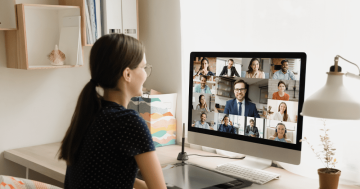Lindsay Tigar* says our bodies reveal more about our messages than our voices ever do, so understanding how you’re perceived by the way you hold yourself is important.

Photo: Сергей Корчанов
Although your co-workers and manager might not understand tiny shifts in your behaviour instantly, you’re giving away many invitations into your psyche simply via your body language.
According to professional corporate trainer, business consultant, and entrepreneur Denise M. Dudley, all people communicate using seven channels: facial expressions, eye contact, posture, hand gestures, voice tone, voice loudness, and verbal content.
While she explains that many professionals are picky with their word choices, very few practise or give a second thought to the other six venues.
This is a big loss, considering many studies indicate difficulty pairing sentences with sentiments.
“Our bodies are actually revealing more about our messages than our voices ever [are],” Dudley told Ladders.
“When we’re delivering a message — any message, good or bad, large or small — how we look as we’re delivering the message is … probably more important than our words if we intend to be understood.”
Especially in the office setting, where everything from words to presentation to inaction means something, understanding how you’re perceived by the way you hold yourself is key.
Even if you’re not intentionally sending out a particular message, your hand movements or facial expressions could tell another story.
Here, experts decode office body language and give their best tips on how to match your mind to your mannerisms:
Assertive eye contact shows confidence
Your parents probably encouraged you to always meet the eyes of friends, family members, or teachers when you were growing up, but now that your mother isn’t there to subtly reprimand you for darting eyes, you might be slacking.
Dudley says there are two times when making clear, assertive eye contact is important in business: when you’re giving instructions and when you’re sharing information.
This is because when you’re being intentional and purposeful with your eyes, you’re demonstrating your confidence.
It also helps, according to Dudley, to ensure the person you are talking to feels connected and at ease around you.
Don’t think you can win a staring contest during a long discussion?
That’s okay.
Dudley adds that breaking eye contact for a mere few seconds is welcome, since it indicates you’re positive, too.
“You’re showing that you’re engaged in the conversation, you’re confident about what you’re saying, and you’re an open, friendly person,” she adds.
Glancing upwards or rolling your eyes looks untrustworthy
When you’re uncomfortable, you might tend to look up, down, or anywhere to avoid locking glances with whoever is causing you distress.
Or, when you’re inwardly frustrated, you might not be able to conceal your dissatisfaction on your face.
Dudley says these habits are very common — and all send the wrong message.
“When you avoid eye contact, you signal that you’re not engaged with the person you’re communicating with, you’re distracted, you’re painfully shy or you don’t like them,” she says.
“When you frequently glance upward, you signal that you’re unsure of yourself, you don’t believe or trust what the other person is saying, or that you wish you were someplace else.”
“Rolling your eyes is universal body language.”
“It’s sarcastic, dismissive, disapproving and downright rude.”
When you need to let out your stress, take a walk around the block or find a private conference room to blow off steam.
The office isn’t a place for a meltdown.
Good posture shows you’re open
Ever been on a first date when your could-be love interest appears particularly charismatic, but you can’t pinpoint why?
Even if they aren’t overly funny or witty, something about them has you soaking up their good vibes.
Dudley says an open, relaxed, and strong posture can speak volumes about a person, without uttering a single word.
“When you do this, you look open and non-judgemental, ready to handle whatever comes your way.”
“Putting your shoulders back signals that you’re comfortable with yourself, able to ‘own your own space,’ confident, and unafraid.”
Folding your arms makes you unapproachable
On the other hand, when another online dating app match can’t seem to unglue their arms from their chest, you’ll likely wonder if they’re interested in you at all.
As a frequent habit of professionals when they’re in a situation where they don’t feel comfortable to express themselves, this motion has the same effect.
“This signals that you’re closed, not open to new ideas, uptight, unapproachable, unfriendly, or not wanting to communicate — or maybe all of the above,” Dudley says.
Want to argue that, hey, you’re just cold in your over-airconditioned office?
Dudley says to throw on a sweater or, better yet, target your self-esteem.
“Make a concerted effort to place your arms at your sides,” she recommends.
“If this feels too exposed, some people find it easier to hold a notebook or a pen, which then gives one of your hands something to do while you’re standing or sitting.”
Leaning forward shows you’re listening
Ever have someone in your life do anything — and everything — while you’re trying to update them on the latest development in your life?
It’s an annoying habit for a generation that’s glued to their phones and always thinking about what’s next, instead of living in the moment.
Dudley says you can ensure your colleagues trust you — and that feel like they’re being heard — by doing a simple move: leaning in.
This subtle shift indicates you’re not only ready, but you’re all ears.
“This signals to the other person that we’re interested, engaged, and actively listening to them,” she explains.
“Most people know what this ‘leaning forward’ action feels like because we all do it naturally when we’re hearing something important.”
“So, given that it’s practically a universal component of our body language, everyone understands what it means: it encourages the other person and gives them positive reinforcement while they’re speaking.”
* Lindsay Tigar is a freelance travel and lifestyle journalist. She tweets at @LindsayTigar and her website is lindsaytigar.com.
This article first appeared at www.theladders.com.











